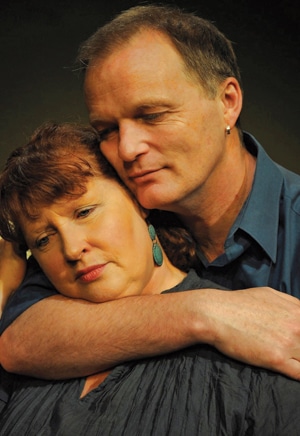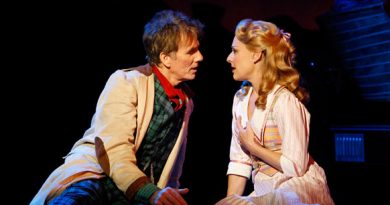La Mama: Love Is My Sin
Love Is My Sin is a beautiful and complex layering of Shakespeare’s sonnets with a woman’s voice, a man’s voice and a cello’s voice. It explores the language of the master’s sonnets alongside the language of human emotion.

Director Kate Herbert discovered this script at its first – and only other – performance at Peter Brook’s theatre in Paris. She quickly decided she wanted to see it performed again.
Brook’s script consists only of 29 Shakespearean Sonnets – no directions, no character allocations. No interpretation of any kind. Herbert and her two performers, Jenny Lovell and Geoff Wallis, took on this daunting task with reverence, respect and a passionate work ethic. Herbert described to me, after the show, how they took the sonnets word by word, line by line, as they worked towards their own understanding.
However, while the performer’s interpretations are naturally vital to the performance, the intent is to provoke ours. The staging is a canvas on which the audience reads our own stories. The script doesn’t call for any number, gender or age of actors, however Herbert chose to follow Brook’s staging by casting a man and a woman. While Brook’s performers were in their 70s, Lovell and Wallis are middle age. This choices offers a traditional romantic narrative to understand the sonnets by, however the specific elements of the story must be filled in by ourselves as we draw together the performance’s threads. Depending on what show you see, depending on where your focus is drawn, the story will change from person to person. I saw the many years of a marriage and its challenges as two people grow old, wanting to do it together yet often struggling with themselves and each other.
And if, like me, you struggle to easily comprehend the sonnets, there is almost as much to understand from the timbre of the voices, the body language, while enjoying how all the sounds meet in the space.
The inclusion of the cello is a beautiful touch, unique to this staging. Herbert said she chose the sections from Bach according to how the sonnets were speaking to them (she, Lovell and Wallis) at the time, and what they felt was needed at certain moments.
The young cellist, Helen Barclay, adds a wonderful layer to the production. Along with the music, she provides another interpretation of the performance. Her face shows her responses to the characters, shows when her attention is fully fixed or when it glides away. While the fourth wall is maintained between the audience and the two actors, Barclay is a fascinating breach and insight, half audience, half performer.
The product of all this is a guided tour through a beautiful selection of Shakespeare and Bach, melding classic poetry with classical music into an experience that proves their continued ability to delight, move and inspire our imaginations.


